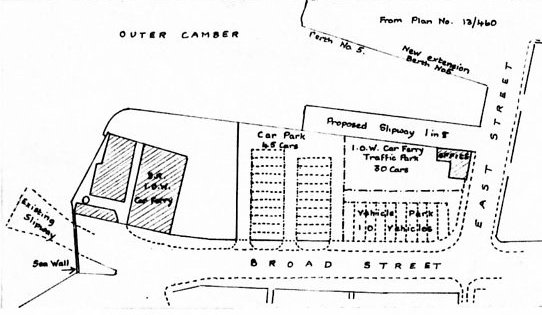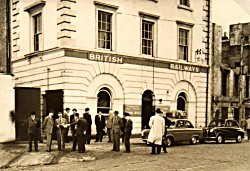
The Final Days
As early as 1929 there had been a valid case for a complete redevelopment of Point. During the winter months with little traffic the Point area coped well but the coming of Summer was a completely different matter. On a Saturday there could be 15 boats a day, all fully booked, and the cars were often parked all the way up Broad Street to Grand Parade. Added to this, there were still animals being driven up the street for the special cattle boats. Despite being presented with detailed plans for the redevelopment the City Council prevaricated for decades, but after World War 2 they were faced with an impossible situation and another plan was submitted in 1949.

Once again the Council put off making the vital decision which would have involved the demolition of much of the eastern side of Broad Street, including the House at Point and the Star and Garter, and a section of East Street. The initial costs were presented at £63,000, exclusive of the cost of purchasing the land, but by 1952 this had risen to £100,000 and the Council were urged to drop the plan.
Instead they approved it in principle and asked the City Engineer to come up with an alternative plan. A test boring revealed soft clay to a depth of 50-60 feet and a trial piling cost nearly £500 and yet again the plan was put on the back burner. During this period the Star and Garter had started to show signs of collapse and the top two stories were removed. This did not rectify the situation and the rest of the building was demolished shortly afterwards.

1955 saw a renewed effort to set a plan in motion but there was a concern that British Rail were thinking of pulling their ferries out of Point to a new base in Gosport. This would have involved a considerable financial loss to the Corporation and rendered the redevelopment of Point much less viable. British Rail issued a statement that they were not intending to pull out of Point at this time but that they envisaged a time when ferries capable of carrying 40 cars would come on stream and these would be too large for the slipway at Point. This galvanised the Corporation and new plans were drawn up for a new slipway, capable of taking 300' boats be built alongside the rear of the Broad Street properties.

The scheme was by now estimated to cost £126,800 but by June 1956, with British Rail committing itself to remain at Point, it was approved.
Although the plan included use of the land on which the Star and Garter had stood the House at Point was not initially earmarked for demolition however a survey revealed that the building was in a far worse state than had been assumed. The centuries had certainly taken their toll and this had been exacerbated by the wartime bombing. The fate of 102 Broad Street was now settled and in February 1960 it too was demolished, a process that was so thorough that all the records of the various companies that had occupied the building were destroyed along with its fabric.

With the buildings out of the way work proceeded swiftly and the new terminal building and slipway were officially opened by the Lord Mayor, Councillor Ralph Bonner Pink, on 7th July 1961. The cutting of the ribbon was a signal for the first line of cars to board the MV Fishbourne.
Thus began a most successful period for the car ferry service; a success story that would in the space of just 20 years outgrow it's facilities. New ferries were introduced that were so long that the slipway could no longer accommodate the service which in February 1982 left the Point terminal for ever.